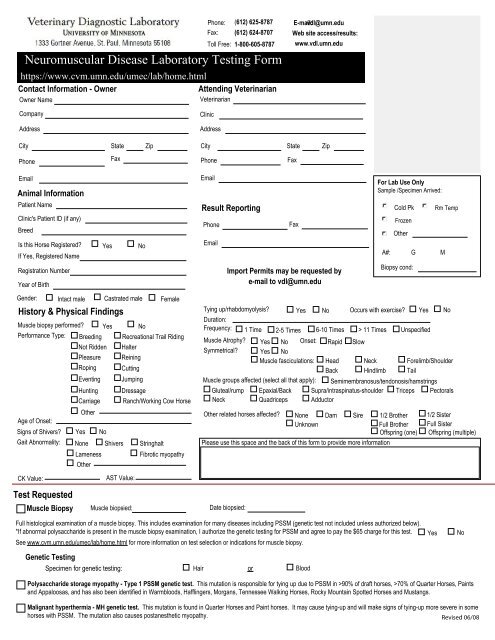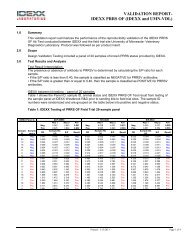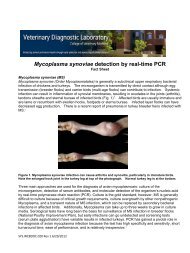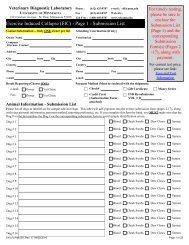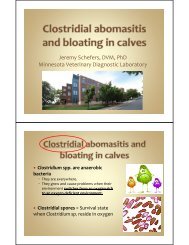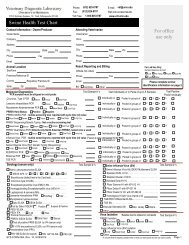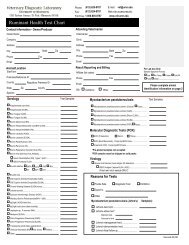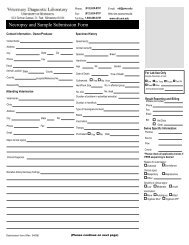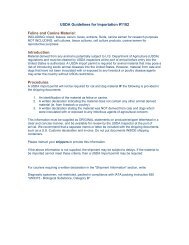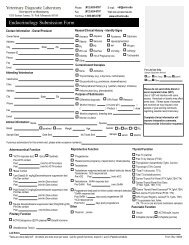Neuromuscular Disease Laboratory Testing Form - Veterinary ...
Neuromuscular Disease Laboratory Testing Form - Veterinary ...
Neuromuscular Disease Laboratory Testing Form - Veterinary ...
Create successful ePaper yourself
Turn your PDF publications into a flip-book with our unique Google optimized e-Paper software.
https://www.cvm.umn.edu/umec/lab/home.htmlContact Information - OwnerAttending VeterinarianOwner NameVeterinarianPhone: (612) 625-8787Fax: (612) 624-8707Toll Free: 1-800-605-8787<strong>Neuromuscular</strong> <strong>Disease</strong> <strong>Laboratory</strong> <strong>Testing</strong> <strong>Form</strong>E-mail: vdl@umn.eduWeb site access/results:www.vdl.umn.eduCompanyClinicAddressAddressCityStateZipCityStateZipPhoneFaxPhoneFaxEmailAnimal InformationPatient NameClinic's Patient ID (if any)BreedIs this Horse Registered? Yes NoIf Yes, Registered NameRegistration NumberYear of BirthGender: Intact male Castrated male FemaleHistory & Physical FindingsMuscle biopsy performed? YesNoPerformance Type: Breeding Recreational Trail RidingNot Ridden HalterPleasure ReiningRoping CuttingEventing JumpingHunting DressageCarriage Ranch/Working Cow HorseOtherAge of Onset:Signs of Shivers? Yes NoGait Abnormality: None Shivers StringhaltLamenessFibrotic myopathyOtherCK Value:AST Value:Test RequestedMuscle BiopsyMuscle biopsied:EmailResult ReportingPhoneEmailFaxImport Permits may be requested bye-mail to vdl@umn.eduTying up/rhabdomyolysis?Duration:Yes No Occurs with exercise? Yes NoFrequency: 1 Time 2-5 Times 6-10 Times > 11 Times UnspecifiedMuscle Atrophy? Yes No Onset: Rapid SlowSymmetrical? Yes NoMuscle fasciculations: Head Neck Forelimb/ShoulderBack Hindlimb TailMuscle groups affected (select all that apply): Semimembranosus/tendonosis/hamstringsGluteal/rump Epaxial/Back Supra/intraspinatus-shoulder Triceps PectoralsNeck Quadriceps AdductorOther related horses affected? None Dam Sire 1/2 Brother 1/2 SisterUnknownFull Brother Full SisterOffspring (one) Offspring (multiple)Please use this space and the back of this form to provide more informationDate biopsied:For Lab Use OnlySample /Specimen Arrived:Cold PkFrozenOtherA#: G MBiopsy cond:Rm TempFull histological examination of a muscle biopsy. This includes examination for many diseases including PSSM (genetic test not included unless authorized below).*If abnormal polysaccharide is present in the muscle biopsy examination, I authorize the genetic testing for PSSM and agree to pay the $65 charge for this test.See www.cvm.umn.edu/umec/lab/home.html for more information on test selection or indications for muscle biopsy.Genetic <strong>Testing</strong>Specimen for genetic testing:HairorBloodYesNoPolysaccharide storage myopathy - Type 1 PSSM genetic test. This mutation is responsible for tying up due to PSSM in >90% of draft horses, >70% of Quarter Horses, Paintsand Appaloosas, and has also been identified in Warmbloods, Hafflingers, Morgans, Tennessee Walking Horses, Rocky Mountain Spotted Horses and Mustangs.Malignant hyperthermia - MH genetic test. This mutation is found in Quarter Horses and Paint horses. It may cause tying-up and will make signs of tying-up more severe in somehorses with PSSM. The mutation also causes postanesthetic myopathy.Revised 06/08
Phone: (612) 625-8787Fax: (612) 624-8707Toll Free: 1-800-605-8787<strong>Neuromuscular</strong> <strong>Disease</strong> <strong>Laboratory</strong> <strong>Testing</strong> <strong>Form</strong>https://www.cvm.umn.edu/umec/lab/home.htmlE-mail: vdl@umn.eduWeb site access/results:www.vdl.umn.eduIt is a <strong>Veterinary</strong> Diagnostic <strong>Laboratory</strong> Policy to submit samples and report results to your veterinarian. Direct involvement of your veterinarian allows foroptimal management of this genetic disease as well as other concurrent medical conditions your horse may have that will affect its management.Genetic <strong>Testing</strong> ProtocolsGenetic testing can be performed on either whole blood OR on mane or tail hair samples.If submitting whole blood: Draw 3 - 7 ml into a purple top EDTA tube clearly labeled with the horse's and owner's ID.If submitting hair: Pull twenty mane or tail hairs with roots intact. Inspect the hair to ensure that a clear bulb is present on the roots of the sample. Therequired DNA for the test cannot be obtained from cut hair. Place the hairs in a completely sealed envelope or plastic bag and label the bag with horse'sand owner's ID.Muscle Biopsy ProtocolsIt is important to select the most appropriate muscle for biopsy in order to get an accurate diagnosis. In general, we recommend open surgical biopsies.*Exertional myopathies and Polysaccharide Storage Myopathy (PSSM); biopsy Semimembranosus or Semitendinosus muscle.*Equine Motor Neuron <strong>Disease</strong>; biopsy Sacrocaudalis muscle.* Immune-Mediated Myositis and horses with atrophy of topline muscles; biopsy a fresh Semimembranosus combined with 3-4 formalin fixed 14 gaugeTruCut samples of epaxial or glutal muscles.*For evaluation of focal muscle atrophy, an open biopsy of the specific muscle group is most appropriate.For detailed muscle biopsy procedures please refer to our website: www.cvm.umn.edu/umec/lab/biopsy_instructions.htmlPacking and Shipping the Biopsy:·Enclose a completed submission form for each animal.·Do not squeeze, squish, or otherwise disturb the muscle sample, as that can damage cells.·A ½ - 1" cube of fresh muscle should be wrapped in saline moistened gauze, placed in a hard, watertight container for protection, and shippedovernight on ice packs in an insulated container to the address above. The gauze should be moist and wrung out. Please do not ship samplesfloating in saline.·Fresh samples are best, since frozen muscle samples for histochemical analysis require special processing prior to freezing. If circumstances aresuch that a biopsy cannot be submitted that day (e.g. death of animal on a weekend), samples can be placed in a freezer and submitted onMonday on ice packs. This is not ideal and should be avoided if at all possible.·<strong>Form</strong>alin fixed - If samples larger than TruCuts are submitted, they should sit in the air for five minutes before they are placed in formalin to preventcontraction bands from forming.Shipping instructions: Enclose a completed submission form for each animal. Label the tube or envelope with owner and animal name. Blood samplesmust be shipped within 48 hr. of collection. Place blood samples on a gel packs, place samples in an insulated container and ship overnight to theaddress below. Hair samples can be shipped by regular mail.Address:<strong>Veterinary</strong> Diagnostic <strong>Laboratory</strong>University of Minnesota1333 Gortner AveSt. Paul, MN 55108Phone: (612) 625-8787PAGE 2


